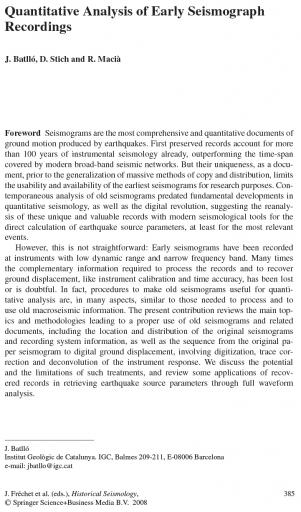In Pubblicazioni

Batlló J. , Stich D. and R. Macià (2008). Quantitative Analysis of Early Seismograph Recordings, IN J. Fréchet et al. (eds.), Historical Seismology, Springer Science+Business Media B.V, 2008.
Foreword
Seismograms are the most comprehensive and quantitative documents of ground motion produced by earthquakes . First preserved records account for more than 100 years of instrumental seismology already, outperforming the time-span covered by modem broad-band seismic networks. But their uniqueness, as a document, prior to the generalization of massive methods of copy and distribution, limits the usability and availability of the earliest seismograms for research purposes. Contemporaneous analysis of old seismograms predated fundamental developments in quantitative seismology, as well as the digital revolution, suggesting the reanalysis of these unique and valuable records with modem seismological tools for the direct calculation of earthquake source parameters, at least for the most relevant events.
However, this is not straightforward: Early seismograms have been recorded at instruments with low dynamic range and narrow frequency band. Many times the complementary information required to process the records and to recover ground displacement, like instrument calibration and time accuracy, has been lost or is doubtful. In fact, procedures to make old seismograms useful for quantitative analysis are, in many aspects, similar to those needed to process and to use old macroseismic information. The present contribution reviews the main topics and methodologies leading to a proper use of old seismograms and related documents, including the location and distribution of the original seismograms and recording system information, as well as the sequence from the original paper seismogram to digital ground displacement, involving digitization, trace correction and deconvolution of the instrument response. We discuss the potential and the limitations of such treatments, and review some applications of recovered records in retrieving earthquake source parameters through full waveform analysis.

